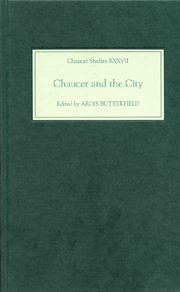Book contents
- Frontmatter
- Contents
- List of Illustrations
- Dedication
- Preface
- List of Contributors
- Abbreviations
- Map
- INTRODUCTION
- LOCATIONS
- 2 Greater London
- 3 The Production of Space in Chaucer's London
- 4 Chaucer's Poetics of Dwelling in Troilus and Criseyde
- COMMUNITIES
- INSTITUTIONS
- AFTERLIVES
- Bibliography
- Index
- CHAUCER STUDIES
4 - Chaucer's Poetics of Dwelling in Troilus and Criseyde
from LOCATIONS
Published online by Cambridge University Press: 05 February 2013
- Frontmatter
- Contents
- List of Illustrations
- Dedication
- Preface
- List of Contributors
- Abbreviations
- Map
- INTRODUCTION
- LOCATIONS
- 2 Greater London
- 3 The Production of Space in Chaucer's London
- 4 Chaucer's Poetics of Dwelling in Troilus and Criseyde
- COMMUNITIES
- INSTITUTIONS
- AFTERLIVES
- Bibliography
- Index
- CHAUCER STUDIES
Summary
Whether London is absent from the Canterbury Tales or not, in this essay I ask how and why parts of Troy are so insistently present in Troilus and Criseyde. Chaucer does not give us, except obliquely, what most writers of Troy-books do, namely long, visually rich descriptions of Priam's imperial Troy being built up and then burnt to the ground. Nor does he limit himself as Boccaccio had, mainly to a single subjectively rendered love story. Instead, he interweaves two sharply juxtaposed experiences of Troy, one focused on the practice of everyday life in ancient Troy, the other, on the well-known history of Troy's fall.
The first three books of Troilus give vibrant energy to specific architectural places within an imagined Trojan cityscape. Here the poet houses the formulaic stages in an Ovidian love affair, locating one stage after another ex ordine within closely grouped palaces and houses in Troy's best neighbourhood. By contrast, through the last two books of Troilus, the text occludes the domestic spaces of neighbourhood life in Troy. Two of the dwellings crucial to the unfolding of the plot in Books II and III – those belonging to Deiphebus and Pandarus – fade from sight. At the same time, what remains of the other two palaces is only what Chaucer had found in Boccaccio. In particular, Criseyde's darkened bedroom in her own palace becomes the principal locus within which the two lovers anxiously question how and where to dwell and love in the face of Criseyde's brutally changed, war-determined circumstances.
- Type
- Chapter
- Information
- Chaucer and the City , pp. 57 - 76Publisher: Boydell & BrewerPrint publication year: 2006



